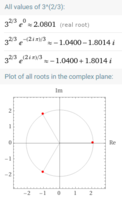First, BEDMAS is a simplifying acronym designed to help beginning students.why does -3^2 translate to -9 .
I thought -3^2 meant (-3)^2 which gives me 9 . Is there any connection of Bedmas with the evaluation of this expression.
Second, the minus sign means has at least three different meanings in mathematics. When it is placed BETWEEN TWO number indicators, it means to do the operation of subtraction. It is being used as a BINARY operator which works on two numbers. When it is placed IN FRONT OF A SINGLE number indicator, it means to do the operation of negation. When it is placed in front of a numeral, it also indicates that the number is less than zero; it is being used as a relational symbol like = or < as well as an operator.
In the order of operations, negation comes after multiplication and division but before addition and subtraction.
So [MATH]- 3^2 * 2 = - (3^2) = - (9) = - 9 \ne (- 3)^2.[/MATH]
This means that [MATH- 3^2 + 20 = 11 = 20 - 3^2.[/MATH]
If you are prime minister of India, then you an Indian citizen.Suppose A is my proposition "c and b are positive real no's and X is a real no" and B is another proposition "the identities are valid "
Then If A is true I see then B has to be true for any combination of no's I take; with keeping in mind the values are taken matching with the constraint in proposition A.
But there is no A =true B= False Case according to my experiment .
Now if A is false then B can be true still.
I checked.(this was the misconception.i had)
And another case can be both A and B are false which they showed to prove the failure of the law.
Ok the law is valid for all Integer exponent and b and c must be non zero Complex no's .
You are not prime minister of India.
Therefore, you are not an Indian citizen.
It is a logical fallacy that
A entails B
A is false
Thus, B is false.
EDIT: Dr. Peterson and I agree. He says to treat negation as though it were multiplication by negative 1. I say it comes beteen multiplication and division. The results are the same.
Last edited:

